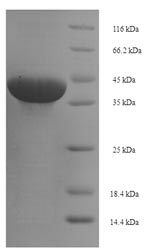The gene encoding the Human BTN3A1 protein (30-254aa) is incorporated into a plasmid vector to generate recombinant plasmid, which is then introduced into e.coli cells. The e.coli cells containing the recombinant plasmid are selected and cultured under conditions that stimulate the expression of the gene of interest. A N-terminal 6xHis-SUMO tag is attached to the protein. After expression, affinity purification is employed to isolate and purify the recombinant Human BTN3A1 protein from the cell lysate. Denaturing SDS-PAGE is utilized to resolve the resulting recombinant Human BTN3A1 protein, revealing a purity level exceeding 90%.






